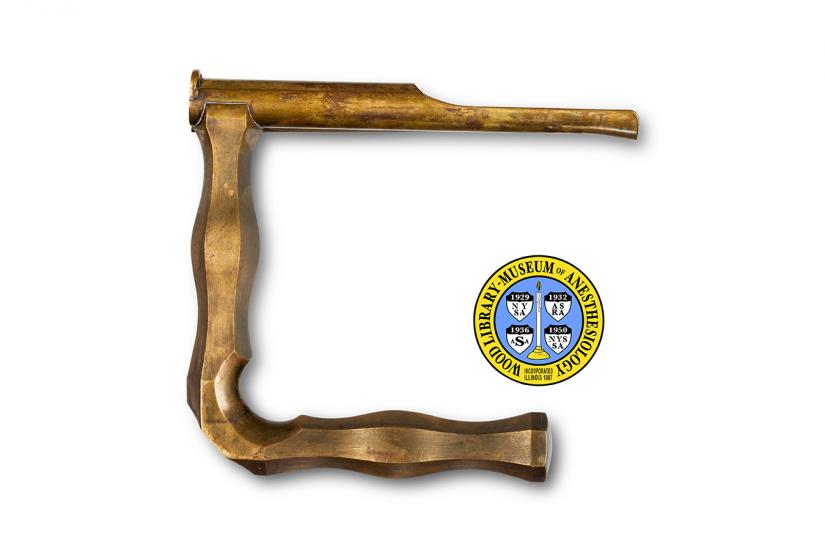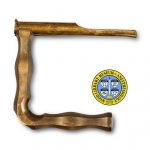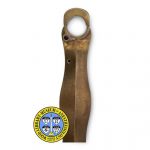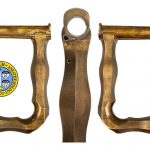Jackson Laryngoscope
Dr. Chevalier Jackson (1865-1958) is considered the father of bronchoscopy and laryngoscopy. His method for removing foreign bodies from the esophagus, breathing passages and lungs without surgery saved the lives of countless children who had swallowed or inhaled dangerous objects. Prior to his work, 98% of all such incidents were fatal. His efforts to prevent other accidental deaths led to the passage of the Federal Caustic Poison Act of 1927, which requires warning labels on all poisonous substances.
Dr. Jackson invented over a dozen instruments for endoscopy (looking inside the body.) He also aided Dr. Paluel Flagg in the design of the Flagg endotracheal tube. In 1911, he described the Jackson Direct Laryngoscope. This was the first laryngoscope to incorporate an electric light. With this new feature, laryngoscopes quickly became part of the standard equipment of anesthesiologists. During general anesthesia, these doctors use a number of tools to assist the patient's breathing. A laryngoscope is used to view the larynx (voicebox), which is the opening to the trachea and lungs. The blade serves to keep the patient’s tongue out of the way while guiding the endotracheal tube into the position where it will remain throughout the surgery, carrying air and anesthetic gases to the patient's lungs.
Catalog Record: Jackson Laryngoscope
Access Key: aknx
Accession No.: 2003-08-04-1 B
Title: [Jackson Laryngoscope.]
Author: Jackson, Chevalier, 1865-1958.
Corporate Author: George P. Pilling & Son Company.
Title variation: Alt Title
Title: Jackson’s direct laryngoscope.
Title variation: Alt Title
Title: Jackson’s separable speculum for passing bronchoscopes and for direct
laryngoscopy.
Publisher: [Philadelphia] : Philling-Phila, [1915-1955].
Physical Descript: 1 laryngoscope : brass ; 15 x 2.5 16.5 cm.
Subject: Laryngoscopes.
Subject: Intubation, Intratracheal – instrumentation.
Subject: Laryngoscopy.
Subject: Airway Management Equipment.
Subject: Jackson, Chevalier, 1865-1958.
Note Type: General
Notes: Title based on the common name for the object. Alternate titles are from
illustrations in Dr. Jackson’s 1907 and 1915 books.
Note Type: General
Notes: Early year in the date range for the possible date of manufacture is based on
the shape of the handle – the dramatic ergonomic design was introduced
sometime between Dr. Jackson’s 1915 and 1922 books. The later year (1955) is
a rough estimate based on the condition and material (brass) of the
laryngoscope. The date range could change if new documentation that indicates
that the dates should be corrected.
Note Type: Citation
Notes: Jackson C. Foreign bodies in the trachea, bronchi and oesophagus-the aid of
oesophagoscopy, bronchoscopy, and magnetism in their extraction. Laryngoscope
April, 1905;15(4):257-281. https://books.google.
com/books?id=SJVFAAAAYAAJ&dq=%22Malignant+disease+in+the+nose%22+laryngoscope
1905&source=gbs_navlinks_s. Accessed March 31, 2014.
Note Type: Citation
Notes: Jackson C. Instrumental aids to bronchoscopy and esophagoscopy. Laryngoscope.
June, 1907;17(6):492-494.
Note Type: Citation
Notes: Jackson C. Instrumentarium. Bronchoscopy and Esophagoscopy: A Manual of
Peroral Endoscopy and Laryngeal Surgery. Philadelphia: W.B. Saunders Company;
1922:50-51.
Note Type: Citation
Notes: Jackson C. Instruments. In: Tracheo-Bronchoscopy, Esophagoscopy and
Gastroscopby. St. Louis: The Laryngoscope Company; 1907:15-32.
https://archive.org/details/tracheobronchosc00jackuoft. Accessed January 12,
2014.
Note Type: Citation
Notes: Jackson C. Peroral endoscopy and laryngeal surgery. Saint Louis: The
Laryngoscopy Company; 1915:20.
Note Type: Citation
Notes: Jackson C. Upper tracheoscopy and bronscopy. Laryngoscope.
1907;17(10):785-787.
Note Type: Citation
Notes: Levitan RM, Hagberg CA. Upper airway retraction: new and old laryngoscope
blades. In: Hagberg CA, ed. Benumof and Hagberg’s Airway Management. 3rd ed.
Philadelphia: Elsevier/Saunders; 2013:510.
Note Type: Citation
Notes: Society proceedings, American Laryngological, Rhinological and Otological
Society: presentation of intruments. Laryngoscope. September, 1905;15(9):739.
Note Type: Citation
Notes: Zeitels SM. Chevalier Jackson’s contributions to direct laryngoscopy. J Voice
1998;12(1):1-6.
Note Type: Physical Description
Notes: One all brass laryngoscope with a “U”-shaped handle; The ‘floor; of the blade
can slide out to create space, but is currently in place; Although capable of
accepting a light, there is no light in the space for one; The handle widens
and narrows to aid the grip; The handle has the manufacturer markings
“PILLING-PHILA U.S.A.”, “16”, and J 1088″; Hand engraved on the joint of the
horizonal and vertical portion of the handle is “NH-16” and “59912”.
Note Type: Reproduction
Notes: Photographed by Mr. Steve Donisch, June 11, 2013.
Note Type: Historical
Notes: The Jackson Laryngoscope was designed by Chevalier Jackson, MD (1865-1958) to
aid in viewing the opening to the trachea and esophagus. His earliest designs
developed during the first decade of the 20th century, did not include the
eye-catching ergonomic handle that is a feature of the laryngoscope described
here. They did include a number of features new to laryngoscope design.
Dr. Jackson’s laryngoscope was the first to have a small built-in light bulb
near the very end of the blade. This continues to be an important feature of
laryngoscopes used today.
His early laryngoscopes also included a separate tube on the exterior of the
blade for the suction of fluids away from the airway and surgical site. The
laryngoscope described here does not have a suction tube, but it does have a
removable portion on the blade, which was another feature of his early
designs. When in place, the removable portion allowed the laryngoscope to act
as a guide for the insertion of a tube, called a bronchoscope, through the
larynx and into the trachea. After the bronchoscope was inserted into the
trachea, the removable portion of the laryngoscope allowed the bronchoscope
to remain in place while the laryngoscope was removed from the patient’s
mouth.
Dr. Jackson not only designed a number of medical instruments he pioneered
and improved techniques for seeing into the trachea, esophagus and stomach,
as well as for removing dangerous foreign bodies from these passageways.
Countless other physicians, including anesthesiologists, learned Dr.
Jackson’s methods via clinics that he held in Pittsburgh and Philadelphia, as
well as through his influential publications. The anesthesiologist Paluel J.
Flagg (1886-1970) sought Dr. Jackson’s assistance and worked with him to
develop a flexible metal endotracheal tube for anesthesia (see the Flagg
Endotracheal Tube).
Note Type: Exhibition
Notes: Chosen for the WLM website (noted November 4, 2013).




